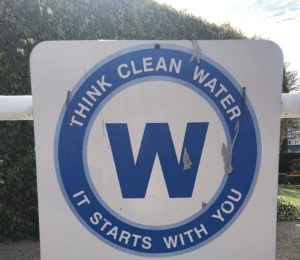Welcome to the 11th issue of Shoots! Each Shoots! issue highlights a business emerging from somewhere unexpected – demonstrating increasingly important principles for the 21st century or responding to a major disruption. For those who have not read Shoots! before, we’ve covered a range of topics, including live theater reinvented in response to COVID, craft beer created from surplus local produce, and virtual staffing using military spouses.
——————————
A COMMON, PROFOUND INSIGHT UNEARTHS VERY DIFFERENT OPPORTUNITIES
As different as each is, these prior Shoots! articles featured entrepreneurs who tapped into a valuable supply source that would otherwise go to waste – out-of-work actors, already-ripe fruit, and military spouses sitting idle at faraway military bases.
Gate 5, a high-impact environmental infrastructure company located in Irvine, California, is also harnessing the supply of an unappreciated asset. But their supply source – sewage – is even more abundant! Gate 5 transforms sewage sludge into electrical power, clean water and building material – scarce commodities with high demand.
THE PROBLEM
Do you know what happens after you flush your toilet today? Yes, your waste runs through sewer lines to your local treatment plant. But that’s only the start of the journey! For many Americans, especially those in East and West Coast cities, diesel-powered trucks and trains transport sewage hundreds of miles away for disposal. New York’s sewage can end up as far as Georgia or Alabama; Southern California sends its sludge to rural counties or Arizona.

Processed sludge being loaded into a truck for transport to Arizona.

Sewage sludge is responsible for 67,000 trucks on California freeways annually.
The problem extends well beyond transport. The basics of today’s sewage treatment process is over a century old, built using assumptions that were true decades ago: lots of time, low electricity and fuel costs, and abundant land to process and dispose of sewage. These conditions no longer exist. Today, municipalities are falling behind – insufficient capacity, paying increasing power and diesel bills, and constantly searching for rural areas to accept its sludge. It’s becoming harder to find such partners; residents near sludge disposal sites are also concerned about odors, methane emissions and harmful contaminants of concern (e.g., PFAS and PFOS) that persist in the food chain.
As lifelong Southern Californians, founders Lisa Heinz and Richard Sherman have witnessed pollution and climate change’s toll on their environment. When presented with the prospect of acquiring technology to process waste products, they sensed an opportunity to play a role in addressing climate change themselves. They connected with Steve Delson, a key figure in the building of Orange County’s planned communities through the 90s. As Gate 5’s co-founder and CEO, Steve’s incredible persistence and creativity complemented Lisa and Rich’s passion and vision, allowing them to iterate and refine their solution over a decade.
THE GATE 5 SOLUTION: 5 S’s
The unique aspects of Gate 5’s solution can be easily described in 5 S’s:
Sustainable: Gate 5’s process breaks down sludge into 100% safe and usable components. Sludge is dried into biofuel and ignited, generating surplus electricity, clean water and a glassy powder called ‘fly ash’ that can be used in concrete or asphalt. With Gate 5’s process, even though sewage may increase with population growth, there will be no additional negative impact on the environment!
Speedy: Sewage sludge has its highest caloric value when fresh, possessing a thermal value equal to coal without the harmful emissions. Gate 5’s 2-day process is a huge advantage over the conventional 26- to 30-day cycle. A Gate 5 plant does not require the massive sludge storage vats found at conventional wastewater treatment plants. And earlier combustion unleashes substantially more energy.
Simple: Gate 5’s system utilizes no chemical or bacterial additives to break down the sludge. Like a load of laundry, sludge is filtered and then dried with hot air, prior to being ignited. Screening, drying and furnace components have already proven durable in similarly demanding industrial settings. The hot air used for drying is recycled from furnace, saving considerable energy.
Scalable: A Gate 5 system can be scaled to add capacity to, or even replace entire facilities. New system modules can also be deployed to gradually replace aging components in conventional wastewater plants. Gate 5 systems can also help support the remaining 75 percent of the world’s population that still does not have access to wastewater treatment facilities. A small system can be delivered in containers by boat or plane and installed, even in the most remote locations.
Safe: The Gate 5 process does not produce methane emissions because sludge is not given time to decompose. Moreover, because the sludge is converted into biofuel and ignited at temperatures approaching 2000° Fahrenheit, harmful compounds that persist in our food chain are broken down when processed through the Gate 5 system.
CHANGE IS HAPPENING
Even though the wastewater industry is typically slow to evolve, several factors have begun to drive more rapid change.
- Cost: higher energy and fuel costs make the status quo much less attractive
- Land disposal options: less viable due to increased regulations and community resistance
- Environmental concerns: significantly less tolerance for methane and CO2 emissions
- Demographic shifts: population growth and migration away from cities will drive need for new communities
- Obsolescence: many US wastewater treatment facilities are approaching the end of useful life
RECENT GATE 5 BREAKTHROUGHS
After years of steady but slow progress, Gate 5 has made incredible strides in the past two years. They built numerous strategic partnerships, including one with Stanford University through which they won the American-made Water Resources Recovery Prize from the US Department of Energy in 2020. They won a $1.6 million grant from the California Energy Commission in August 2021. Gate 5 has also entered into an agreement with the Santa Margarita Water District in Orange County to build a demonstration system. Other municipalities are keenly observing Gate 5’s progress. As the technology is optimized there will be considerable demand for environmentally sustainable wastewater management solutions.

Each of us can play a role in providing clean water for future generations.
With our Earth’s climate clock already striking midnight, it’s so refreshing to come across a company like Gate 5 with potential to change the world. Their simple solution to truly recycle the most abundant renewable resource we generate as humans back into elemental pieces like energy, water and ash gives us hope to sustain future generations without further depleting the resources we still have.
If you are interested (or know someone who might be), Gate 5 is currently raising a seed investment round to fund the construction of the Santa Margarita system in Orange County. This is an opportune time to support a company with world-changing potential, as it is still poised for growth. Please reach out to Steve Delson or Charlene Rainey for more information.
Kyle Okimoto is the founder of Market Junctions, which helps businesses and leaders harness the power of disruption to generate positive change. Kyle is a consultant, advisor and investor in startups ranging AltoIRA (self-directed retirement accounts for alternative investments — Series B, $70.3m raised), Percent Technologies (high yield short term alternative investments — Series A, $12.5m raised), Janover Ventures (commercial real estate financing marketplace), Trade Exchange (connecting top stock pickers to top stock pickers) and ARIS Technology (robotic quality control laser scanning).


